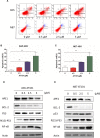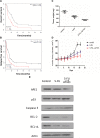AT101 exerts a synergetic efficacy in gastric cancer patients with 5-FU based treatment through promoting apoptosis and autophagy
- PMID: 27144437
- PMCID: PMC5085166
- DOI: 10.18632/oncotarget.9119
AT101 exerts a synergetic efficacy in gastric cancer patients with 5-FU based treatment through promoting apoptosis and autophagy
Abstract
Gastric cancer remains a disease with a high mortality rate despite of multiple therapeutic strategies. So far, it is very important to develop new treatment approaches to improve current therapeutic efficacy in gastric cancer. Apurinic/apyrimidinic endonuclease (APE1) involves in DNA base excision repair (BER) during DNA damage pathway. APE1 was found to be associated with poor overall survival with gastric cancer patients. In the in vitro experiment, we tested APE1 inhibitor-AT101 could potently inhibit gastric cancer cell growth and further induce cancer cell apoptosis and autophagy through p53-dependent pathway. Downregulation of APE1 by AT101 has ability to suppress gastric cancer cell migration and renewal through inhibition of CD133, Nanog and LC3expression. Based on findings that Her-2 positive expression cases has poor prognosis from our dataset and TCGA database, we investigated the role of AT101 in synergetic efficacy with 5-FU treatment in Her-2 overexpression gastric cancer in vivo, indicating that AT101 is able to enhance 5-FU in the shrinkage of xenograft mice tumor and induction of cell apoptosis. In summary, the data obtained from our study showed APE1 is guided as a potential therapeutic target for gastric cancer. AT101 could be regarded as a potent inhibitor to promote chemotherapeutic sensitivity in patients with gastric cancer.
Keywords: 5-FU; APE1; AT101; Her-2 positive; gastric cancer.
Conflict of interest statement
The authors declare no conflicts of interest.
Figures






Similar articles
-
Prediction of survival prognosis of non-small cell lung cancer by APE1 through regulation of Epithelial-Mesenchymal Transition.Oncotarget. 2016 May 10;7(19):28523-39. doi: 10.18632/oncotarget.8660. Oncotarget. 2016. PMID: 27074577 Free PMC article.
-
Identification of a novel potential antitumor activity of gossypol as an APE1/Ref-1 inhibitor.Drug Des Devel Ther. 2014 May 9;8:485-96. doi: 10.2147/DDDT.S62963. eCollection 2014. Drug Des Devel Ther. 2014. PMID: 24872679 Free PMC article.
-
Small-molecule BH3 mimetic and pan-Bcl-2 inhibitor AT-101 enhances the antitumor efficacy of cisplatin through inhibition of APE1 repair and redox activity in non-small-cell lung cancer.Drug Des Devel Ther. 2015 Jun 8;9:2887-910. doi: 10.2147/DDDT.S82724. eCollection 2015. Drug Des Devel Ther. 2015. PMID: 26089640 Free PMC article.
-
Sequential treatment with AT-101 enhances cisplatin chemosensitivity in human non-small cell lung cancer cells through inhibition of apurinic/apyrimidinic endonuclease 1-activated IL-6/STAT3 signaling pathway.Drug Des Devel Ther. 2014 Dec 12;8:2517-29. doi: 10.2147/DDDT.S71432. eCollection 2014. Drug Des Devel Ther. 2014. PMID: 25548514 Free PMC article.
-
Inhibitors of nuclease and redox activity of apurinic/apyrimidinic endonuclease 1/redox effector factor 1 (APE1/Ref-1).Bioorg Med Chem. 2017 May 1;25(9):2531-2544. doi: 10.1016/j.bmc.2017.01.028. Epub 2017 Jan 21. Bioorg Med Chem. 2017. PMID: 28161249 Review.
Cited by
-
APE1 stimulates EGFR-TKI resistance by activating Akt signaling through a redox-dependent mechanism in lung adenocarcinoma.Cell Death Dis. 2018 Oct 31;9(11):1111. doi: 10.1038/s41419-018-1162-0. Cell Death Dis. 2018. PMID: 30382076 Free PMC article.
-
Inhibition of APE1 Expression Enhances the Antitumor Activity of Olaparib in Triple-Negative Breast Cancer.Evid Based Complement Alternat Med. 2022 Apr 13;2022:6048017. doi: 10.1155/2022/6048017. eCollection 2022. Evid Based Complement Alternat Med. 2022. PMID: 35463096 Free PMC article.
-
Upregulation of the APE1 and H2AX genes and miRNAs involved in DNA damage response and repair in gastric cancer.Genes Dis. 2019 Apr 5;6(2):176-184. doi: 10.1016/j.gendis.2019.03.007. eCollection 2019 Jun. Genes Dis. 2019. PMID: 31194025 Free PMC article.
-
AT101 Suppresses Gastrointestinal Stromal Tumor Growth and Promotes Apoptosis via YAP/TAZ-CCND1 and FBXW7-MCL1 Axes.Ann Surg Oncol. 2025 Aug;32(8):5991-6004. doi: 10.1245/s10434-025-17247-3. Epub 2025 Mar 27. Ann Surg Oncol. 2025. PMID: 40148719
-
Base excision repair and its implications to cancer therapy.Essays Biochem. 2020 Oct 26;64(5):831-843. doi: 10.1042/EBC20200013. Essays Biochem. 2020. PMID: 32648895 Free PMC article. Review.
References
-
- Torre LA, Bray F, Siegel RL, Ferlay J, Lortet-Tieulent J, Jemal A. Global cancer statistics, 2012. CA: a cancer journal for clinicians. 2015;65:87–108. - PubMed
-
- Jiang Y, Kimchi ET, Montero AJ, Staveley-O'Carroll KF, Ajani JA. Upper gastrointestinal tumors: current status and future perspectives. Expert review of anticancer therapy. 2008;8:975–991. - PubMed
-
- Helleday T, Petermann E, Lundin C, Hodgson B, Sharma RA. DNA repair pathways as targets for cancer therapy. Nature reviews Cancer. 2008;8:193–204. - PubMed
MeSH terms
Substances
LinkOut - more resources
Full Text Sources
Other Literature Sources
Medical
Research Materials
Miscellaneous

